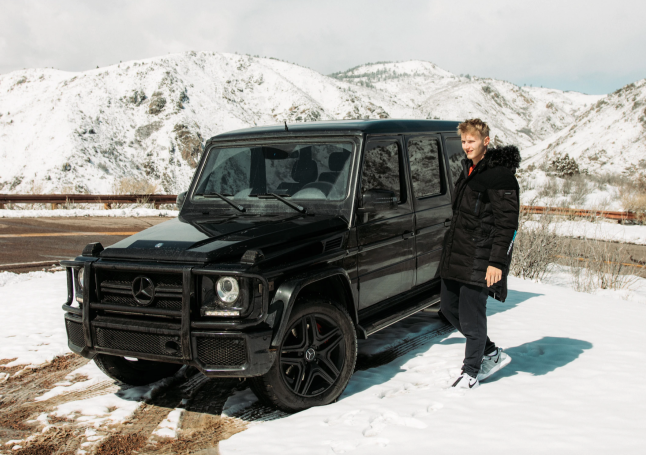A top safety organization is recommending that parents put their teen drivers in larger cars that are safer for occupants but more lethal for pedestrians and cyclists — and sparking a backlash about why it seems to be enlisting the youngest drivers in the SUV arms race rather than demanding that cars be made smaller and safer for everyone.
In honor of Teen Driver Safety Week, the Insurance Institute for Highway Safety recently revisited its August study about the role of vehicle design in protecting the youngest motorists on our roads, which found that U.S. teens "are the riskiest drivers," but "drive the least-safe vehicles" — i.e. smaller cars.
Those cars, though, are actually among the safest on the road ... for people who walk and roll. Studies have long shown that megacars are two to three times more likely than a sedan to kill a walker in the event of a crash, and today's hulking SUVs are a staggering eight times more likely to kill a child who isn't behind the wheel.
Nonetheless, the Institute expressed concern that the proportion of teens driving older, smaller automobiles hadn't gone down since 2008, and recommended that parents explore buying their kids newer and bigger models with better occupant safety ratings — prompting transportation researcher David Zipper to ask whether "pedestrian and cyclist deaths ... count" towards the organization's mission to reduce car crash deaths.
Notably, the Institute's report did not mention that teens already represent the single age demographic that's most likely to kill a vulnerable road user, even though teens are currently among the least likely to drive the kind of large cars that are deadliest to people outside the vehicle.
Why in the world is IIHS— whose mission is to reduce car crash deaths— telling people to avoid smaller cars?
— David Zipper (@DavidZipper) October 19, 2022
Do pedestrian and cyclist deaths not count? https://t.co/8u8rKMnYCc
The Institute quickly updated its social media accounts to clarify that it was "pursuing a comprehensive approach to improve safety for everyone, including pedestrians and cyclists," and in an email to Streetsblog, underscored the importance of giving teens mobility options besides driving, rather than just arming them with ever-bigger tanks.
"A teen that doesn’t drive can’t crash. That’s the ideal," said Joseph Young, director of media relations.
Young hesitated, though, to withdraw the Institute's recommendation outright, emphasizing that the negative effects of putting kids in monster trucks could be offset by other policies, like raising the licensing age, increasing the number of mandatory practice hours for permit holders, and prohibiting young drivers from transporting multiple passengers or driving at night. The Institute maintains a calculator that estimates that by implementing those recommendations, fatal crashes could be decreased by as much as 50 percent in permissive states like South Dakota.
"We know that [teens not driving at all] is not realistic in many parts of the country, particularly in rural areas, where teens may not have other options for getting around," he added. "So, we also give states other options for tweaking their laws where research shows teen crashes and deaths can be reduced."
What is the impact on total crash deaths -- including pedestrians, cyclists, and those in other cars -- when teens (the least experienced drivers, by definition) drive big SUVs or trucks instead of smaller vehicles?
— David Zipper (@DavidZipper) October 19, 2022
Zipper rightly wondered, though, whether those theoretical safety gains might be negated if the average U.S. car continues to swell in size — and if parents follow the Institute's recommendation to put teens inside the biggest models.
Megacar or no, safety experts say that young drivers are already four times more likely to be involved in a fatal crash than an adult on a per-mile basis, a phenomenon they attribute to a combination of inexperience, immaturity, impulsivity, and the fact that the human brain doesn't completely finish developing until its early- to mid-twenties.
In 2020, drivers under 20 years old held just 5.1 percent of licenses, but were involved in 8.5 percent of fatal crashes — and according to the National Highway Traffic Safety Administration, that stat also holds true for fatal pedestrian crashes, 8.5 percent of which also involved teens and very young adults between 2011 and 2020, and for cyclist crashes, for which the percentage was 8.8.
If smaller cars are more dangerous, then it follows that car size should be standardized for maximum safety. No more huge trucks - just one size. Let’s run that ad campaign and see how truck owners react.
— al417 (@public9965) October 19, 2022
The Institute may well be right that parents' best bet to keep their children safe may be to put them in the biggest, most heavily-armored car they can afford, at least as long as America remains as car dependent and SUV-dominated as it is today. But for those who can't or don't want to choose a vehicle that's more likely to kill other people's babies, some advocates hope that regulators will take action to address the root reason why we need a Teen Driver Safety Week at all: a society that gives young people few truly safe choices, no matter how they get around.






